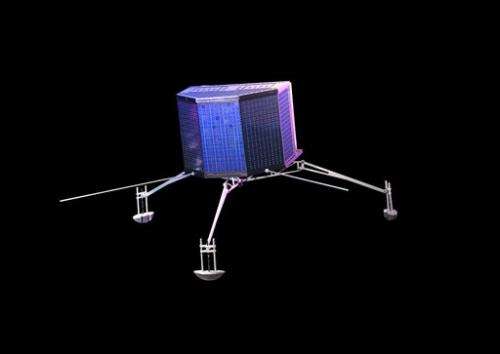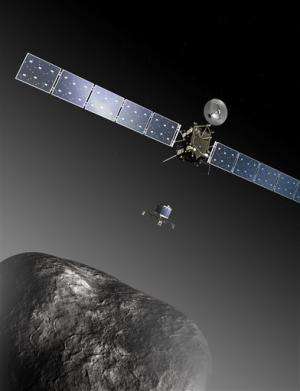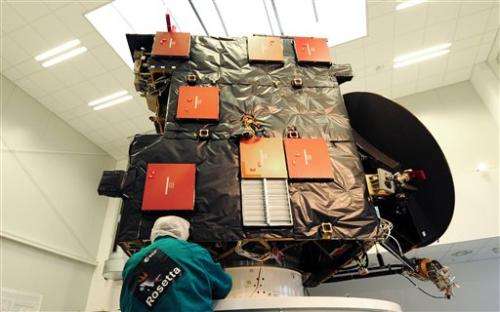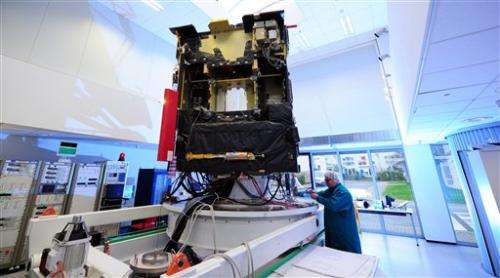This undated image provided by the European Space Agency ESA shows an artist's impression of the Philae lander. Scientists at the European Space Agency are expecting their comet-chasing probe Rosetta to wake from almost three years of hibernation at 11 a.m. Monday Jan. 20, 2014 (1000 GMT; 5 a.m. EST) and phone home to say all is well. (AP Photo/ESA ATG medialab , Astrium E, Viktor, File)
Waking up after almost three years of hibernation, a comet-chasing spacecraft sent its first signal back to Earth on Monday, prompting cheers from scientists who hope to use it to land the first space lander onto a comet.
The European Space Agency received the all-clear message from its Rosetta spacecraft at 7:18 p.m. (1818 GMT; 1:18 p.m. EST)—a message that had to travel some 800 million kilometers (500 million miles).
In keeping with the agency's effort to turn the tense wait for a signal into a social media event, the probe triggered a series of "Hello World!" tweets in different languages.
Dormant systems on the unmanned spacecraft were switched back on in preparation for the final stage of its decade-long mission to rendezvous with the comet named 67P/Churyumov-Gerasimenko. Systems had been powered down in 2011 to conserve energy, leaving scientists in the dark about the probe's fate until now.
Because of the time it took Rosetta to wake up, and the long distance between the spacecraft and Earth, the earliest possible hour for a signal to arrive was 6:30 p.m.
"I think it's been the longest hour of my life," said Andrea Accomazzo, the spacecraft's operations manager at ESA's mission control room in Darmstadt, Germany. "Now we have it back."
This image provided by the European Space Agency ESA shows an artist's impression of the Rosetta orbiter deploying the Philae lander to comet 67P/Churyumov–Gerasimenko. The image is not to scale; the Rosetta spacecraft measures 32 m across including the solar arrays, while the comet nucleus is thought to be about 4 km wide. Scientists at the European Space Agency are expecting their comet-chasing probe Rosetta to wake from almost three years of hibernation at 11 a.m. Monday Jan. 20, 2014 (1000 GMT; 5 a.m. EST) and phone home to say all is well. (AP Photo/ESA, C.Carreau, File)
Scientists will now take control of Rosetta again, a procedure slowed by the 45 minutes it takes a signal to travel to or from the spacecraft, he said.
The wake-up call is one of the final milestones for Rosetta before it makes its rendezvous with comet 67P in the summer. The probe will then fly a series of complicated maneuvers to observe the comet—a lump of rock and ice about four kilometers (2.5 miles) in diameter—before dropping a lander called Philae onto its icy surface in November.
The lander will dig up samples and analyze them with its instruments.
Although the spacecraft was launched almost a decade ago, the instruments aboard Rosetta and the Philae lander are still considered cutting edge, said Joel Parker of the Southwest Research Institute in Boulder, Colorado. The institute developed a specialized camera called ALICE that can detect different chemicals in the comet.
Rosetta is named after a block of stone that allowed archeologists to decipher ancient Egyptian hieroglyphs. Scientists hope the space mission will help them understand the composition of comets and thereby discover more about the origins and evolution of our solar system.
A scientist of European space agency ESA stands at an airworthy copy of space probe 'Rosetta' in the ESA control center in Darmstadt, Germany, Monday, Jan. 20, 2014. Scientists at the European Space Agency are expecting their comet-chasing probe Rosetta to wake from almost three years of hibernation at 11 a.m. Monday Jan. 20, 2014 (1000 GMT; 5 a.m. EST) and phone home to say all is well. The scientists are facing an agonizing wait of several hours until the first signal reaches Earth. (AP Photo/dpa, Daniel Reinhardt)
Comets are regarded as flying time capsules because they are essentially unchanged for the last 4.6 billion years. Scientists have speculated that comets may be responsible for the water found on some planets. And like asteroids, comets also pose a theoretical threat to life on Earth.
"Over the millennia, comets have actually affected our evolution," said Paolo Ferri, head of mission operations at the European Space Agency. "There are many theories about comets hitting the Earth and causing global catastrophes. So understanding comets is also important to see in the future what could be done to defend the Earth from comets."
In this photo provided by the European Space Agency, ESA, Monday Jan. 20, 2014 technicians celebrate after receiving the Rosetta wake up signal in the control room of ESA in Darmstadt, Germany. Waking up after almost three years of hibernation, a comet-chasing spacecraft sent its first signal back to Earth on Monday, prompting cheers from scientists who hope to use it to achieve the first landing on a comet.The European Space Agency received the all-clear message from its Rosetta spacecraft at 7:18 p.m. (1818 GMT; 1:18 p.m. EST) -- a message that had to travel some 800 million kilometers (500 million miles). (AP Photo/ESA, Juergen Mai, File)
The mission is different from NASA's Deep Impact, a spacecraft that fired a projectile into a comet in 2005 so scientists could study the resulting plume of matter. NASA also managed to land a probe on an asteroid in 2001, but comets are much more volatile places because they constantly release dust and gas that can harm a spacecraft.
A scientist of European space agency ESA stands at an airworthy copy of space probe 'Rosetta' in the ESA control center in Darmstadt, Germany, Monday, Jan. 20, 2014. Scientists at the European Space Agency are expecting their comet-chasing probe Rosetta to wake from almost three years of hibernation at 11 a.m. Monday Jan. 20, 2014 (1000 GMT; 5 a.m. EST) and phone home to say all is well. The scientists are facing an agonizing wait of several hours until the first signal reaches Earth. (AP Photo/dpa, Daniel Reinhardt)
NASA is planning another space rock mission between 2019 and 2021. The agency is looking into sending a robotic spaceship to lasso a small asteroid and haul it close to the moon, where spacewalking astronauts would explore it.
More information: www.esa.int/rosetta
© 2014 The Associated Press. All rights reserved.




























